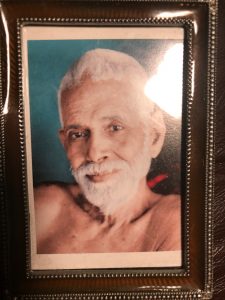“If the mind is restless on account of a sense of the imperfect and unsatisfactory character of what befalls us or what is committed or omitted by us, then it is wise to drop the sense of responsibility and free-will by regarding ourselves as the ordained instruments of the All-wise and All-powerful, to do and suffer as He pleases. He carries all burdens and gives us peace.”
(Sri Ramana Maharshi)

Question: Who am I?
‘Who am I?’
Bhagavan: The physical body, composed of the seven dhatus, is not ‘I’. The five sense organs… and the five types of perception known through the senses… are not ‘I’. The five parts of the body which act… and their functions… are not ‘I’. The five vital airs such as prana, which perform the five vital functions such as respiration, are not ‘I’. Even the mind that thinks is not ‘I’. In the state of deep sleep vishaya vasanas remain. Devoid of sensory knowledge and activity, even this [state] is not ‘I’. After negating all of the above as ‘not I, not I’, the knowledge that alone remains is itself ‘I’. The nature of knowledge is sat-chit-ananda [being-consciousness-bliss].
Question: What is the nature of the mind?
Bhagavan: That which is called ‘mind’, which projects all thoughts, is an awesome power existing within the Self, one’s real nature. If we discard all thoughts and look [to see what remains when there are no thoughts, it will be found that] there is no such entity as mind remaining separate [from those thoughts]. Therefore, thought itself is the nature of the mind. There is no such thing as ‘the world’ independent of thoughts. There are no thoughts in deep sleep, and there is no world. In waking and dream there are thoughts, and there is also the world. Just as a spider emits the thread of a web from within itself and withdraws it again into itself, in the same way the mind projects the world from within itself and later reabsorbs it into itself. When the mind emanates from the Self, the world appears. Consequently, when the world appears, the Self is not seen, and when the Self appears or shines, the world will not appear.
If one goes on examining the nature of the mind, it will finally be discovered that [what was taken to be] the mind is really only one’s self. That which is called one’s self is really Atman, one’s real nature. The mind always depends for its existence on something tangible. It cannot subsist by itself. It is the mind that is calledsukshma sarira [the subtle body] or jiva [the soul].
Question: What is the path of enquiry for understanding the nature of the mind?
Bhagavan: That which arises in the physical body as ‘I’ is the mind. If one enquires, ‘In what place in the body does this “I” first arise?’ it will be known to be in the hridayam. That is the birthplace of the mind. Even if one incessantly thinks ‘I, I’, it will lead to that place. Of all thoughts that arise in the mind, the thought ‘I’ is the first one. It is only after the rise of this [thought] that other thoughts arise. It is only after the first personal pronoun arises that the second and third personal pronouns appear. Without the first person, the second and third persons cannot exist.
Hridayam is usually translated as ‘Heart’, but it has no connection with the physical heart. Bhagavan used it as a synonym for the Self, pointing out on several occasions that it could be split up into two parts, hrit and ayam, which together mean, ‘this is the centre’. Sometimes he would say that the ‘I’-thought arises from the hridayam and eventually subsides there again. He would also sometimes indicate that the spiritual Heart was inside the body on the right aside of the chest, but he would often qualify this by saying that this was only true from the standpoint of those who identified themselves with a body. For a jnani, one who has realised the Self, the hridayam or Heart is not located anywhere, or even everywhere, because it is beyond all spatial concepts. The following answer[2] summarises Bhagavan’s views on this matter:
I ask you to see where the ‘I’ arises in your body, but it is not really quite true to say that the ‘I’ rises from and merges on the right side of the chest. The Heart is another name for the reality, and it is neither inside nor outside the body. There can be no in or out for it since it alone is… so long as one identifies with the body and thinks that he is in the body, he is advised to see where in the body the ‘I’-thought rises and merges again.
A hint of this can also be found in this paragraph of Who am I? in the sentence in which Bhagavan asks devotees to enquire ‘In what place in the body does this “I” first arise?’
Ordinarily, idam, which is translated here as ‘place’, means only that, but Bhagavan often gave it a broader meaning by using it to signify the state of the Self. Later in the essay, for example, he writes, ‘The place [idam] where even the slightest trace of “I” does not exist is swarupa[one’s real nature]’.
I am
The sadhana of loving God as He really is, as ‘I am,’ with all one’s heart, having rejected all other thoughts, is identical to the path of true devotion as taught by Bhagavan on many occasions:
Question: That is why I am asking you whether God could be worshipped through the path of love.
Bhagavan: … Love itself is the actual form of God, If by saying, ‘I do not love this, I do not love that,’ you reject all things, that which remains is swarupa, that is, the real form of the Self. That is pure bliss. Call it pure bliss, God, atma or what you will. That is devotion, that is realisation, that is everything.
If you thus reject everything, what remains is the Self alone. That is real love. One who knows the secret of that love finds the world itself full of universal love.
Jesus instructed his followers that they should not merely love God with all their heart, they should also love their neighbours as themselves. Here Bhagavan is saying that this automatically happens when the first commandment, loving God with all one’s heart, is fulfilled. When one experiences ‘Love … the actual form of God’, the world itself, including all possible neighbours, is experienced as one’s own Self, and is found to be ‘full of universal love’.
The experience of not forgetting consciousness [‘I am’] alone is the state of bhakti, which is the relationship of unfading real love, because the real knowledge of Self, which shines in the undivided supreme bliss itself, surges up as the nature of love. Only if one knows the truth of love, which is the real nature of Self, will the strong entangled knot of life be untied. Only if one attains the height of love will liberation be attained. Such is the heart of all religions. The experience of Self is only love, which is seeing only love, hearing only love, feeling only love, tasting only love and smelling only love, which is bliss.
***** from Who am I – davidgodman.org
– David Godman is the world’s foremost researcher and scholar of Sri Ramana Maharshi’s life and teachings. He has written or edited 16 books and numerous articles about Sri Ramana, Sri Ramana’s direct disciples, and related topics. His first book, Be As You Are,published in 1985, has become the standard anthology of Sri Ramana’s writings. He has spent most of his life in Tiruvanammalai where Sri Ramana’s ashram is located.
The degree of the absence of thoughts is the measure of your progress towards Self-realisation. But Self-realisation itself does not admit of progress, it is ever the same. Progress is measured by the degree of removal of the obstacles to understanding that the Self is always realised. So thoughts must be checked by seeking to whom they arise. ” (Sri Ramana Maharshi)

